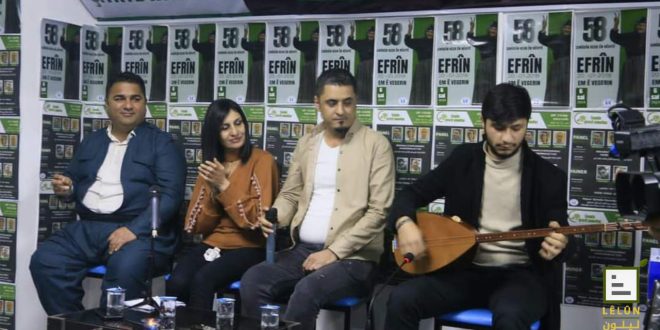The Rojava Intellectuals of Kurdistan Union (HRRK) in his center in Qamishlo held a cultural and artistic debate to memorialize the twelfth anniversary passing of the popular artist “Muhammad Ali Tijo” under the title “Muhammad Ali Tijo, the Memory of Chyayi Kurminj- Kurds Mountain”. The debate began with the screening of a documentary film about artist’s life, the most important stages of his life and excerpts from his songs and some of his famous sayings.
The speakers touched on the oral heritage richness in general and the epic lyric art in particular in the Afrin region since ancient times, where generations have inherited this artistic heritage from their ancestors and grandfathers and passed it from generation to generation by telling ancient epic stories and transforming social, political and historical stories and events into epic songs that shed light important details therein.
The audience then talked about the most important themes and topics that the late “Muhammad Ali Tijo” addressed during his long artistic career and the methods he followed in influencing people, thus becoming a school in itself. Many young artists and singers are still following in his footsteps and style.
The speakers unanimously agreed that the late artist was the “artist of love”. He sang for love with all its powers, including love for the country and man, authenticity, heroism, nature, justice, society, and freedom. These topics were the content of all his songs and interesting conversations that preceded epic singing, this is what distinguishes his style from those who they preceded him.
The speakers stressed that he was not just a popular artist and singer, but rather the artist went beyond that with his speeches in which he sought to develop his society and criticize the negative aspects of prevailing social relations. He was also one of the strongest supporters of the freedom of Kurdish women, and this appeared clearly in many of his sayings and songs, where he says in this Regarding: “Do not force girls to submit to your decisions! Do not pressure them or oppress them!”
The speakers described him as being ahead of his time in his liberal theses and ideas and his pursuit of development and improving the social situation of his people. Although he was illiterate and could not read and write, he was fluent in speaking three languages, Kurdish, Arabic and Turkish and this is evidence of his high cultural level.
Researcher Walid Bakr stressed that in his artistic works he relied on the word that he chose with great care in a language that everyone understood: “He was skilled in using the word, and he was able, with his rhetorical style to greatly influence the audience. Most of the followers of his art are fans of his words, advice, and wisdom. Until people came to the point where his phrases became proverbs, popular proverbs and advice that they used in their conversations.”
He also glorified heroism and heroes. In this field he deserved to be “The memory of Chyayi Kurminj/ The Mountain of Kurds”, as he recorded many social and political events at the level of Kurdistan in general and in the Afrin region in particular. These events and facts that writers, historians, and researchers were unable to record for many reasons.
Among the facts and stories of heroism that took place in the Afrin region, which he documented with his voice in conversation and singing: the story of the rebel against the Ottoman Empire, “Saydi Mamesh” from Maabatli/Mobato, the glorification of “Mustafa Julaq,” one of the most important rebels against the French mandate. Some of the stories and social events that took place, such as: the story of “Raqeeb Ahmed, the story of Salan, the story of the death of the brothers Khalil and Hanan, and the lamentation of Bakr Habash from Baadanli/Baadina, in addition to some events that affected the Kurdish political scene, such as: the uprising of “Sheikh Saeed” and “Laila Qasim.”
The speakers also mentioned that the late man emphasized authenticity and adherence to authentic traditions in his art and speeches, listing examples of the purebred horse, bulbul, and others, meaning the original and principled human being.
It is noteworthy that UNESCO, an affiliate of the United Nations, invited him in 1976 to participate in artistic meetings with artists from around the world. He visited France and the Netherlands for five consecutive years, during which he presented his singing and playing the tanbour.
It is worth noting that the people of the Afrin region, after forced displacement following the occupation of the region in the Turkish “Olive Branch” operation in 2018, have lost much of their material and intangible heritage, and they are no longer even able to visit the graves of their artists on the anniversary of their death. Most of the artists have been subjected to forced displacement like others people of the region, there was no safe place left to practice and memorize their own arts and songs.
The cultural heritage of the Afrin region is subject to loss and disappearance for several reasons, the most important of which are the processes of demographic change that are constantly taking place in the region after the forced displacement of artists and workers in the cultural field, the loss of many recorded folk songs and the lack of strong institutions that support interest in and preservation of folk singing heritage, in addition to systematic practices which is carried out by the de facto authorities in the Afrin region, represented by the military factions and local councils affiliated with the Syrian Interim Government, to restrict the indigenous population and force them to emigrate.
The imbalance in the demographic composition of the region resulted from the large migration of components from outside the region to it who brought a new culture different from the culture of the indigenous people, in addition to preventing those authorities from establishing cultural institutions for the indigenous population concerned with art and heritage.
 Lelun Afrin
Lelun Afrin
